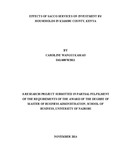| dc.description.abstract | Investment plays an important role in sustaining growth and development of any country.
High rates of investments depend on high rates of saving (Pelrine & Kabatalya, 2005).
SACCOs link borrowers and savers (Tache, 2006). The savers pool their money as
savings and shares against which they borrow in form of loans. SACCOs are not- for-
profit- organizations as their basic purpose is to help members save (Kyendo, 2011).
Kenya has targeted to become a middle income country by year 2030. To achieve this it
will need to increase its level of private savings, more so what is generated from the
households. No known study has been conducted to determine the impact of Saccos on
investment by household in Kenya Therefore the study sought to answer the following
questions: what is the effect of SACCO services on investment by households in Kiambu
County, Kenya? The objective of the study was to assess the effect of SACCO services
on investment by households in Kiambu County, Kenya. This study used a descriptive
survey (Describing the characteristics of existing phenomenon) in soliciting information
on the effect of SACCO services on investment by households in Kiambu County,
Kenya. The target population was all SACCOs in Kiambu County which have been in
existence from 2009 to 2013. The study collected primary and secondary data. Primary
data was collected using a semi structured questionnaire which contained both open and
closed-ended questions. The quantitative data was analyzed by descriptive statistics,
which included frequencies, percentages and measures of central tendency like means;
while the qualitative data was analyzed by content analysis. The study also used multiple
regressions to help determine the relationship between the variables under study. From
the above regression model, the study found out that there were factors influencing
investment by households are total savings by households in SACCOs and total credit to
members (loans). They influenced investment by households positively. The study found
out that the intercept was 1.298 for all years.
The two independent variables that were studied (savings by households and total credit
to members (loans)) explain a substantial 72.3% of investment by households as
represented by adjusted R2 (0.723). This therefore means that the two independent
variables contributes 72.3% of investment by households while other factors and random
variations not studied in this research contributes a measly 27.7 % of investment by
households. The study established that the coefficient for savings by households was
0.271, meaning that savings by households positively and significantly influenced
investment by households. Since financial literacy and experience affect the Personal
Saving Rate among the Sacco members; the study recommends that it’s important that
the management of Sacco’s in collaboration other financial institutions initiates’ financial
management training programs amongst the residents of Kiambu. | en_US |

